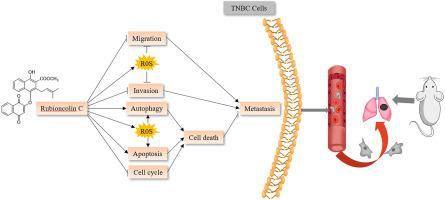Ethnopharmacological relevance
Rubia yunnanensis Diels is a traditional Chinese medicine that has diverse pharmacological activities, including antituberculosis, antirheumatism and anticancers. Rubioncolin C (RC), a natural naphthohydroquinone dimer isolated from the roots and rhizomes of R. yunnanensis Diels, has shown potent antitumor activity. However, the antitumor activity and its potential mechanism of RC in triple-negative breast cancer (TNBC) cell lines remained unclear.
Aim of the study
This study was aim to investigate the anti-proliferation and anti-metastasis activity as well as the potential mechanism of RC on triple-negative breast cancer cells in vitro and in vivo.
Materials and methods
The sulforhodamine B assay, colony formation assay and cell cycle analysis were used to determine the anti-proliferative activity of RC on TNBC. The anti-metastatic activity in vitro of RC was detected through the scratch wound assay, cell migration and invasion assays and gelatin zymography. The flow cytometry, JC-1, GFP-LC3B plasmid transfection, MDC, Lysotracker red and Carboxy-H2DCFDA, DHE, and MitoSOX™ Red staining were performed to investigate the effect of RC on apoptosis, autophagy and ROS level. The apoptosis inhibitor, autophagy inhibitors and ROS inhibitors were used to further verify the antitumor mechanism of RC. The protein levels related with cell cycle, apoptosis, and autophagy were examined with western blotting. In addition, the anti-tumor activity of RC in vivo was assessed in an experimental metastatic model.
Results
In the present study, RC suppressed the proliferation of TNBC cells in a time- and dose-dependent manner via regulating cell cycle. Further experiments showed that RC inhibited the migration and invasion of TNBC cells by downregulating MMPs and inhibiting EMT. Moreover, we demonstrated that RC induced obviously apoptotic and autophagic cell death, activated MAPK signaling pathway and inhibited mTOR/Akt/p70S6K and NF-κB signaling pathways. Furthermore, the excessive ROS was produced after treatment with RC. The antioxygen NAC and GSH could rescue the cell viability and reestablish the ability of cell metastasis, and inhibit the RC-induced apoptosis and autophagy. In a mice lung metastasis model of breast cancer, RC inhibited lung metastasis, and induced autophagy and apoptosis.
Conclusion
These findings clarified the antitumor mechanism of RC on TNBC cell lines and suggested that RC is a key active ingredient for the cancer treatment of R. yunnanensis, which would help RC develop as a new potential chemotherapeutic agent for TNBC treatment.

































 京公网安备 11010802027423号
京公网安备 11010802027423号